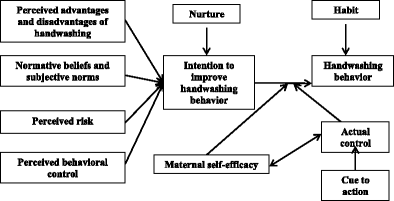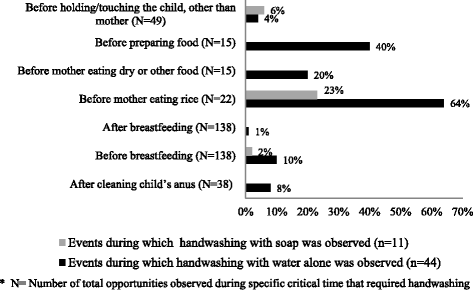Barriers to and motivators of handwashing behavior among mothers of neonates in rural Bangladesh
- PMID: 29642885
- PMCID: PMC5896121
- DOI: 10.1186/s12889-018-5365-1
Barriers to and motivators of handwashing behavior among mothers of neonates in rural Bangladesh
Abstract
Background: To design a maternal handwashing intervention for the newborn period, this qualitative study explored drivers of handwashing among mothers and other caregivers of neonates and infants in two rural areas of Bangladesh.
Methods: We conducted 40 semi-structured observation sessions to observe handwashing behaviors of primiparous and multiparous mothers of neonates, and to understand the contextual factors that facilitated or hampered those behaviors. We then conducted 64 interviews with mothers of neonates and mothers of infants and 6 group discussions with mothers of infants, other female caregivers and fathers to explore perceptions, beliefs, and practices related to handwashing in the neonatal period. Based on a conceptual model and the Theory of Reasoned Action/Theory of Planned Behavior, we developed a conceptual model a priori, we performed thematic analysis to explain determinants of maternal handwashing behaviors.
Results: We conducted 200 h of observation among mothers of neonates. The age range of participating mothers varied between 17 and 25 years and their maximum education was up to 10th grade of schooling. Mothers, other female caregivers and fathers perceived a need to wash hands with or without soap before eating or before feeding a child by hand to prevent diarrhea. Mothers expressed the importance of washing their hands before holding a baby but were rarely observed doing so. All respondents prioritized using soap for visible dirt or feces; otherwise, water alone was considered sufficient. Lack of family support, social norms of infrequent handwashing, perceptions of frequent contact with water as a health threat and mothers' restricted movement during first 40 days of neonate's life, and childcare and household responsibilities adversely impacted handwashing behavior.
Conclusions: Addressing emotive drivers of handwashing within existing social norms by engaging family members, ensuring handwashing facilities and clarifying neonatal health threats may improve maternal handwashing behavior in the neonatal period.
Keywords: Bangladesh; Handwashing; Maternal; Neonatal.
Conflict of interest statement
Authors’ information
SP is working as Assistant Scientist at Programme for Emerging Infections under Infectious Diseases Division, icddr,b, Mohakhali, Dhaka, Bangladesh. She served as qualitative researcher and led several qualitative and mixed method studies including interventions related to hand hygiene and infection control.
Ethics approval and consent to participate
The interviewers read aloud the consent form to potential respondents, explained their voluntary participation in the study, then sought for and obtained written consent (signature or thumb print) when one agreed to take part. The study protocols for Matlab and Habigonj were reviewed and approved by the Ethical Review Committee of icddr,b. The protocol for Habigonj data collection was also approved by the Institutional Review Board of Social and Behavioral Sciences at the University at Buffalo.
Consent for publication
Not applicable.
Competing interests
The authors declare that there is no competing interest regarding the publication of this paper.
Publisher’s Note
Springer Nature remains neutral with regard to jurisdictional claims in published maps and institutional affiliations.
Figures



References
-
- Liu L, Oza S, Hogan D, Perin J, Rudan I, Lawn JE, Cousens S, Mathers C, Black RE. Global, regional, and national causes of child mortality in 2000–13, with projections to inform post-2015 priorities: an updated systematic analysis. Lancet. 2015;385(9966):430–440. doi: 10.1016/S0140-6736(14)61698-6. - DOI - PubMed
-
- Bloomfield SF, BPharm, Aiello AE, Cookson C, O'Boyle C, Larson EL. The effectiveness of hand hygiene procedures in reducing the risks of infections in home and community settings including handwashing and alcohol-based hand sanitizers American. Journal of Infection Control. 2007;35(10, Supplement 1):S27–S64. doi: 10.1016/j.ajic.2007.07.001. - DOI
MeSH terms
Substances
Grants and funding
LinkOut - more resources
Full Text Sources
Other Literature Sources
Medical

